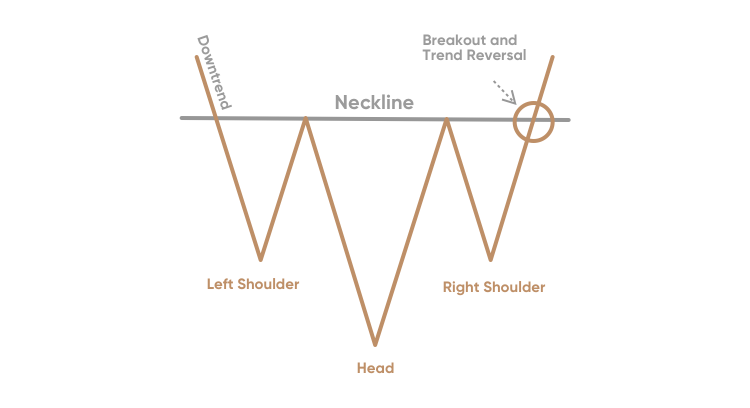The head and shoulders pattern can also form in the opposite direction. This is known as the head and shoulders bottom or the inverse head and shoulders.
The bullish version of the pattern establishes at the bottom of the downtrend and implies that the existing bearish tendency is likely to be reversed, and the price could head higher.
After the peak of the left shoulder is formed, the price goes up completing the first formation. It then falls to a new low followed by a recovery move upwards creating the head.
A corrective reaction downwards occurs to start the formation of the right shoulder, and then the price makes a sharp move up once again. The neckline is then applied, serving as a resistance line.
Once the second shoulder is formed, the price will make a final rally, breaking through the neckline and indicating the completion of the head and shoulders bottom formation and the reversal of the bearish trend.
Another difference between the top and bottom patterns is that the Top formation is typically completed within a few weeks, whereas the Bottom formation may prolong up to several months or even a year.
Trading the head and shoulders pattern
There are a number of strategies traders could consider using when trading with a head and shoulders pattern.
Support and resistance levels. The head and shoulders pattern is a trend reversal pattern and the head and shoulders levels can act as support and resistance levels when the price approaches them. Traders could use these levels to enter or exit trades.
Moving averages (MA). When the price approaches a MA, traders could look to enter a long or short trade.
Stop losses and guaranteed stop losses. Stop losses may be utilised effectively in any type of trading, and this is especially true for head and shoulders patterns. Stop losses could be placed just below the neckline level for a long trade and just above the neckline level for a short trade. Guaranteed stop losses could be used the same way, but require a fee and have no risk of slippage.
Trailing stops. Trailing stops are another valuable tool that traders could consider using when trading head and shoulders patterns. A trailing stop will move with the price and protect profits as the price continues to move
Head and shoulders pattern analysis
When dealing with the head and shoulders top pattern, measuring the vertical distance from the top of the head down to the neckline may help determine an estimated spread amount.
For instance, if the distance represents $10, then once the neckline is broken, technical analysts would predict the price to decline at least another $10 below the neckline price level.
Conversely, when dealing with an inverse pattern, the opposite is true: measuring the vertical distance from the neckline down to the peak of the head gives you a rough idea of how far the price is likely to go upward past the neckline.
Additionally, the head and shoulders pattern is a useful technical analysis tool for measuring and evaluating the minimum probable extent of the subsequent move of the price from the neckline. It also allows indicating a reversal in a trend where the market makes a shift from bullish to bearish or vice-versa. This pattern is considered to be one of the more reliable patterns that predict a trend reversal.
Common mistakes
As with many things when it comes to trading, there are pitfalls traders may want to watch out for. These may include:
One of the most common mistakes made in a head and shoulders trading strategy is not waiting for confirmation. The pattern is not complete until the price breaks through the neckline.
The line connecting the two troughs that form the shoulders should be sloping and the line connecting the highs of the two peaks should be horizontal. If the neckline is not properly identified, the pattern may not be valid.
The pattern should be observed in the context of overall market conditions and current trends. Additionally, traders should consider paying attention to volume and other indicators that can provide additional confirmation.
The target price is usually determined by measuring the distance between the neckline and the highest peak of the head and subtracting this amount from the breakout point. Knowing the target price could help traders manage their risk and plan their trades accordingly.
Lastly, traders should always employ risk management when trading the head and shoulders chart pattern. As with any other trading strategy, it is important to set stop-loss orders and limit potential losses. Additionally, traders should not risk more than they can afford to lose.
Conclusion
The head and shoulders chart pattern can be explained as a technical analysis chart pattern that is used to indicate potential reversals in a market. It can potentially be a useful tool for traders, as it could be used to identify potential reversals in the market.
Identifying the pattern could help traders form a head and shoulders trading strategy allowing them to make more informed decisions.
However, as with any trading strategy, it should be noted that the head and shoulders pattern is not entirely foolproof. Traders should do their own research and exercise caution. They should also remember to never invest or trade with more money than they can afford to lose.











